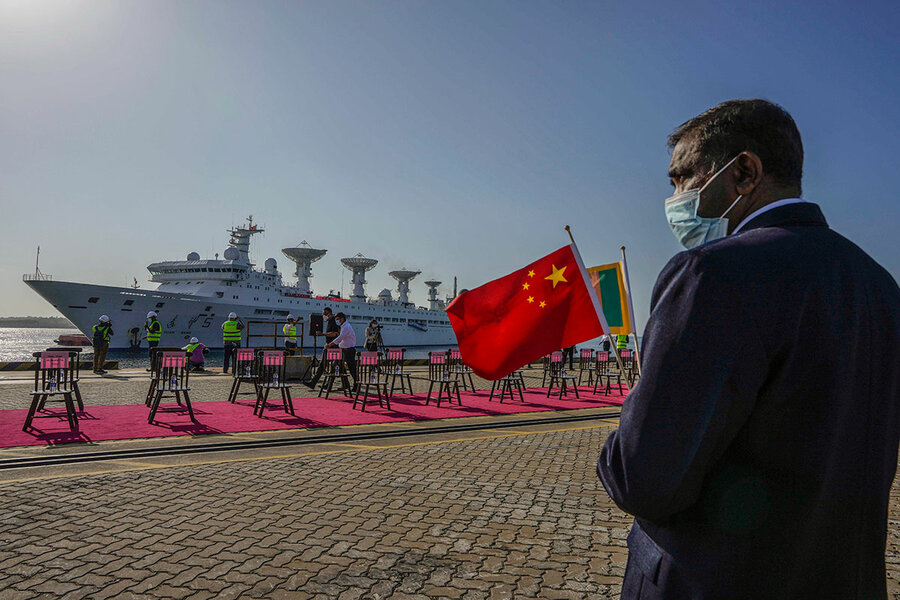Port politics: How China fits into Sri Lanka’s economic crisis
Loading...
China’s financing and operation of Sri Lanka’s Hambantota port, where a Chinese missile-tracking vessel docked this week despite objections from the United States and India, have been raised as a cautionary example of “debt trap diplomacy” – a strategy in which a country loans money to smaller nations, which may not be able to repay their debts, as a way to boost geopolitical influence. Some even blame China for the island nation’s economic nosedive. Yet experts say Sri Lanka’s debt crisis is more complicated, and China is just one player, albeit an important one.
How has China’s lending contributed to Sri Lanka’s debt crisis?
China is Sri Lanka’s biggest bilateral creditor.
Why We Wrote This
China may not have caused Sri Lanka’s debt crisis, but recent moves in the Indian Ocean show how it benefits from lopsided lending.
Sri Lanka’s total public and publicly guaranteed debt was $35.8 billion at the end of 2021. Of that amount, lending by China accounted for $7.1 billion, or 20%, compared with less than 1% in 2001, according to data from Sri Lanka’s finance ministry analyzed by researchers.
Nevertheless, experts say Sri Lanka’s borrowing from China, while significant, is not the main cause of the debt crisis, which saw the country default on its foreign debt for the first time in May. The country’s largest foreign lending source is international sovereign bonds, accounting for 36.5% at the end of 2021. These bonds constituted an even greater share of Sri Lanka’s 2021 foreign debt repayments: 47% compared with China’s 20%.
“The debt crisis is the result of Sri Lanka’s … own poor public finance management,” says Subhashini Abeysinghe, research director at Verite Research, an independent think tank in Colombo. The government’s inability to generate adequate revenue, persistent budget deficits, tax cuts, and meager foreign currency reserves all contributed, she explains.
Meanwhile, “Sri Lanka refused to go to the IMF [International Monetary Fund] or start discussions with lenders on debt restructuring until it [was] too late,” she says.
What is the outlook for China restructuring Sri Lanka’s debt?
China does have a critical role to play in helping Sri Lanka extricate itself from the crisis, experts say.
Based on past practice, Beijing is unlikely to write off loans, but could lengthen repayment periods, says Deborah Brautigam, director of the China Africa Research Initiative at the Johns Hopkins School of Advanced International Studies. Having taken risks with “overexuberant” lending to poor countries, China avoids disclosing details of restructuring agreements to maintain its bargaining leverage. “Chinese, like any creditors, don’t want to lay out a template for what another country can get,” she says.
Moreover, she says such agreements are not popular at home, especially as domestic debt issues mount.
China’s financial institutions are consulting with Sri Lanka on “a proper way to handle the matured China-related debts,” Foreign Ministry spokesman Wang Wenbin said last month. However, no concrete steps have been revealed.
“There is no evidence China is really trying to help Sri Lanka at this time,” says Nilanthi Samaranayake, director of the Strategy and Policy Analysis Program at CNA, an independent research organization in Arlington, Virginia.
Sri Lankan President Ranil Wickremesinghe says he’s encouraged by China’s recent agreement as part of an international committee of creditors to provide debt relief to Zambia. But he noted many creditors want Sri Lanka to seek relief first from the International Monetary Fund.
Is China using its economic power to gain strategic leverage in Sri Lanka?
When China’s satellite- and missile-tracking vessel Yuan Wang 5 docked at Sri Lanka’s Hambantota port this week – despite objections raised by India – experts said it showed how Beijing is using its economic heft to extend its power in the region.
The visit “reflects the continued significance of the Indian Ocean … to China’s strategic interests, and the growing importance of China’s state-owned firms in facilitating China’s global power projection,” said Jeffrey Becker, director of the Indo-Pacific Security Affairs Program at CNA. The dual-use ship helps China control and track its spaced-based civilian and military assets, he says.
China loaned Sri Lanka $1.26 billion to finance the Hambantota port from 2007 to 2014. As Sri Lanka’s debts mounted, China’s state-run firm China Merchants Port Holdings took over management of the port under a 99-year lease for $1.12 billion, which Sri Lanka used to strengthen its foreign reserves.
India is concerned China will use the Hambantota port for military purposes. Sri Lanka delayed the visit for diplomatic consultations, then allowed the Yuan Wang 5 to dock on the stipulation it not conduct any research while in Sri Lankan waters. “Sri Lanka is trying not to get ensnared in the China-India rivalry,” says Dr. Samaranayake, noting that Sri Lanka has a tradition of welcoming foreign vessels and the revenue they generate.
The incident illustrates how Sri Lanka must increasingly balance its relationship with longtime ally India, and major creditor China. “India and China will go back and forth … in South Asia, pushing against smaller and weaker countries,” says Dr. Brautigam. “A little country like Sri Lanka is just going to be a pingpong ball.”






